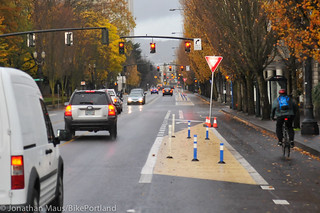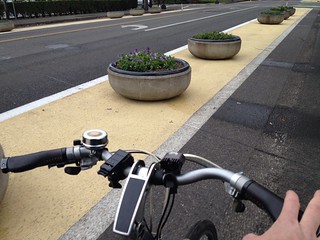
next month to decide the future
of NE Multnomah’s bikeways.
(Photo by J. Maus/BikePortland)
About 16 months since it debuted with its planters and beeswax color, business and real estate development reps and City of Portland staff will sit down and discuss the future of the protected bikeways on NE Multnomah Street.
Billed as a pilot project when they were first installed, the bikeways have undergone extensive research and analysis and there are early signs that they’ve increased ridership and influenced adjacent development. But have they been as “transformative” as promised? How can they be improved? What do the powerful property owners along the street think?
Unlike most transportation projects in Portland, the bikeways on Multnomah were conceived by a private group of business interests that worked closely with the City. There was a more traditional stakeholder committee made up of advocates and citizen activists working to create a carfree street on NE Holladay one block over; but two powerful members of that group voted against those plans, and then successfully switched the focus to NE Multnomah. The City of Portland, working with the Lloyd District Transportation Management Association (TMA), then gathered a private group of business stakeholders and city staff to hammer out the design and details.
The group initially got the design very wrong. It was only after considerable public feedback that the design was improved to what we have now.
While better than what existed before; the bikeways on Multnomah clearly aren’t the world-class facilities they could be. Part of the issue is the place itself: With a shopping mall and high-rise hotels dominating the streetscape, it’s not the type of vibrant, destination-filled street where a quality bikeway can really reach its potential. The Lloyd District in general, also lacks high-quality, non-auto connections to other parts of the street network, thereby limiting the impact of any single bikeway.
Early next month, Go Lloyd (the new name of the Lloyd District TMA) will assemble that same, private working group to chart this project’s future. Lindsay Walker, head of Go Lloyd’s bicycle program, says the group will discuss the usage data collected thus far and hear feedback from adjacent property owners.
Members of this group include City of Portland transportation, parks and environmental services staff, as well as:
- Justin Zeulner – Senior Director of Sustainability and Public Affairs, Portland Trail Blazers/Rose Quarter
- Craig Harlow – IT Analyst at Pacificorp
- Kali Bader – VP at Rembold Companies (a real estate development firm)
- Alan Huston – HR Director at Doubletree Hilton Hotel
- John Fainter – VP of Development at Cypress Equities (owners of Lloyd Center Mall)
- Wade Lange – CEO, Langley Investment Properties
“We’re also going to ask property owners to discuss any upcoming plans for their properties that we might want to keep in mind moving forward,” Walker added.
Overall, Walker says, most stakeholders are “happy with it and would like to see the treatment become permanent.” She’s also aware that the “design needs some adjustments to address some issues.”
If the bikeways are to become permanent, the working group will hammer out short-term maintenance needs (the paint in the buffer zone and the plastic wands already need some help) and brainstorm about what they’d like to see in the long-term.
— Browse the archives for more background on this project.


